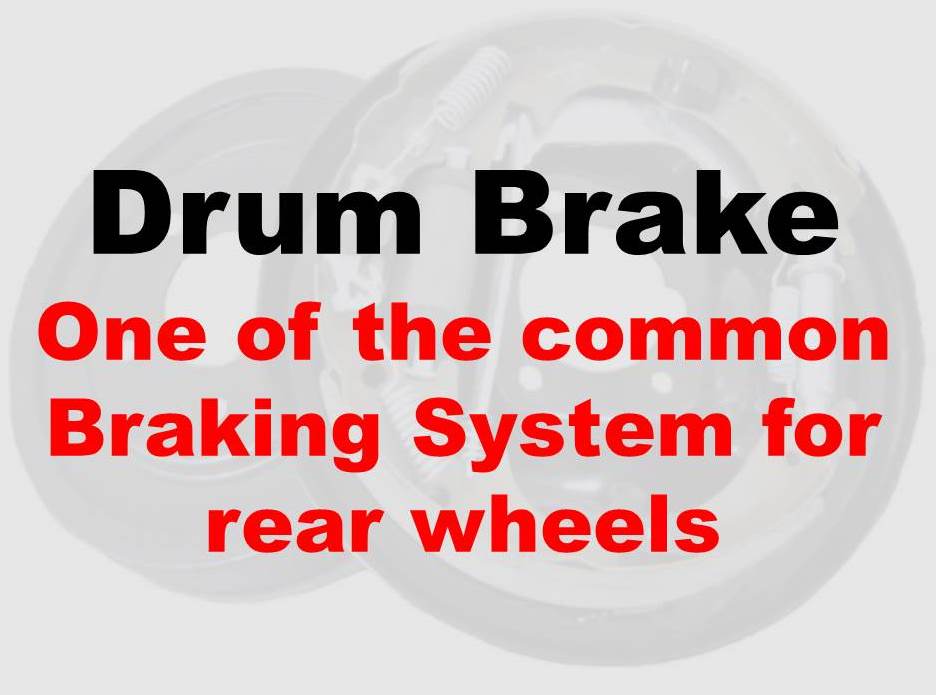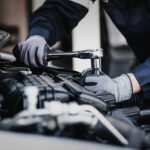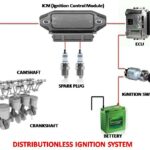Hello friends,
Hope you all are aware about brakes. The device which tends to slow down or stop the vehicle is known as brakes. In this article we will learn about one of the most common method or type of braking any rotary machine is called “DRUM BRAKE”. Drum is an oldest type of braking method. We will discuss about its construction, types, application advantages and disadvantages.

Drum Brake:
Construction:
Its construction can be understand into following point.

Drum:
Drum is attached concentric to the axle hub whereas on the axle casing is mounted a back plate. It is part of the wheel assembly and the friction force act on wheel through drum.
Back Plate:
It is made of pressed steel sheet and is ribbed to increase rigidity and to provide support for expander, anchor and brake shoe. It also protect drum and shoe from mud and dust. Sometimes this plate is also known as torque plate because it absorb complete torque reaction of brake shoe.
Brake shoe:
These are the main part of any braking system. There are two number of shoe which are anchored on the back plate. Shoes are mounted with friction lining. There are two types of brake shoe according to the braking effort. The first one is leading type and other is trailing type.
Leading type Shoe:A shoe which tend to apply brake or dragged along the drum due to its centrifugal action of the when the brake is not applied is called leading shoe. When the brake is applied the net force exerted on the leading shoe is more than the other one.
Trailing Type Shoe:A shoe which tends to thrown of the drum due to its own rotation is called trailing shoe. The net force exerted on the trailing shoe is less than the leading shoe.
Retractor Spring or Return Spring:
This spring is used to keep away shoe from drum when the brake is in released position.
Anchor:
Brake shoes are anchored at one and free at other end. A force is applied at free end to apply braking effort.
Adjuster:
It is attached between anchored end of the brake shoe. It is used to adjust fixed distance between drum and shoe or compensate for wear of friction lining.
Expander:
It is a cam or toggle lever attached to the back plate and used to applied braking effort when required. Expander is fixed or floating type.
Working:
Every braking system works on the principle of friction. Drum brakes also works on it. Its working can be summarized into following points.
- First when the driver wants to apply brake, he presses the brake pedal.
- The brake pedal is attached to the expander through some linkage. For small sized vehicle, the expander is directly attached to the brake pedal by some mechanical linkage but for big or heavy vehicle where required braking force is much more than a human being can apply, the expander is attached through some hydraulic linkage to brake pedal which increases the braking force.
- The expander move or rotate inside the drum which forces brake shoes towards drum. These shoes makes contact with drum during braking condition.
- The friction force generates between the drum and shoe which tends to stop or slow down the vehicle.
- When the brake pedal is released, the expander achieves its initial position. Now the reactor springs come into play and bring braking shoes in its initial position.
- When the brake lining of brake shoe worn out, the adjuster are used to adjust gap between brake shoe and drum.
Types of Drum Brake:
This brake can be divided into following types according to its design.
Fixed expander type
The brake shoe which we have discussed yet is fixed expander type or the expander position is fixed in this braking system. One big problem occur in this system is that, if the one brake shoe is trailing type and other one is leading type, the friction lining of leading one worn out early due to high braking force compare to trailing type. This produces unequal braking effort at two shoes.
Floating expander type
In this system the expander is floating type which adjust its position according to the braking effort by both shoe and make sure that both shoes faces same braking force thus equilizing braking force at both shoe.
Two leading shoe type
In this system one fixed anchor and one floating anchor is used which make both shoes leading types. One big advantage of this type of braking system is that it increases the braking torque due to leading shoe quality.
Two trailing shoe type
This system is also used one fixed and one floating anchor. This shoe decrease the braking effort so it is used with servo brake or power brake. These braking system have better anti fade quality.
Advantages:
- Low cost
- Simple in construction
- Self energize braking system.
Disadvantages
- Heating problem due to all parts are coved into drum itself. So when brakes applied the heat is generated between brake shoe and drum remains entrapped inside the assembly.
- Low efficiency due to heating problem and high wear of shoe lining.
- If water entrapped inside the assembly, it tends to slip the shoe over drum which decrease effectiveness of this braking system.
This is all about drum brake. If you have any query regarding this article, ask by commenting. If you like this article, don’t forget to share it on social networks. Subscribe our website for more informative articles. Thanks for reading it.



